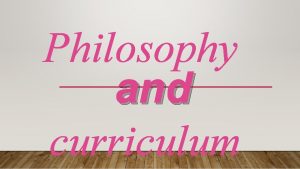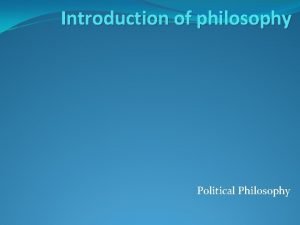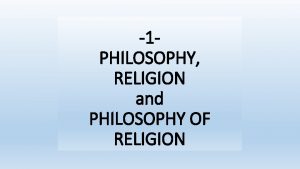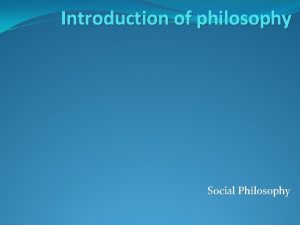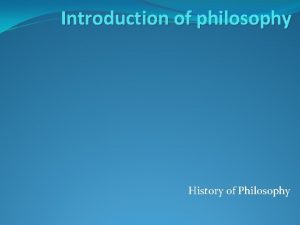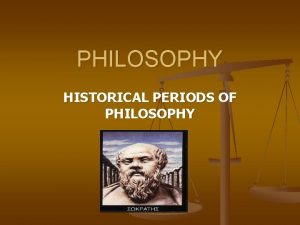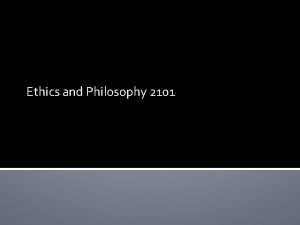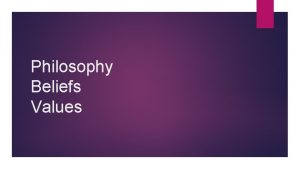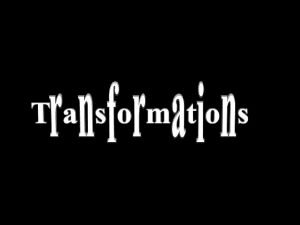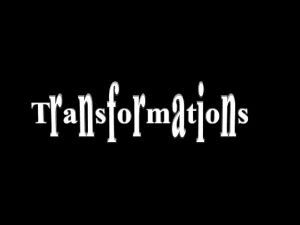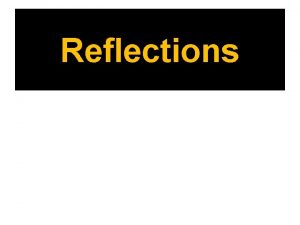CURRICULUM APPROACHES REFLECT THE FOLLOWING Philosophy View of














- Slides: 14

CURRICULUM APPROACHES REFLECT THE FOLLOWING: Philosophy View of Reality History Psychology Social Issue Domains of Knowledge

Each Approach Expresses a Perspective About Curriculum Development Which Impact The design of the curriculum The role of schools, administrators, teachers, learners, curriculum specialist Requirements for evaluation and implementation

TWO MAIN CONTRASTING CATEGORIES OF CURRICULUM APPROACHES TECHNICALSCIENTIFIC NON-TECHNICAL NON-SCIENTIFIC

Curriculum Approaches are Divided in two Categories Technical-Scientific Category Non-Technical/Non-Scientific Category Reflect a traditional orientation about education and formal methods of schooling Challenge traditional theories and practices and reflect the more progressive views about education. Involves a logical step-by-step procedure of problem solving. Focus on the end product & performance of the student. Subject centered design. Backward design aligns under the technical category. Focus on the process and personal relevance for the student. Learner centered & problem centered design.

A. Technical Scientific Category 1. Curriculum development is a plan or blueprint for structuring the learning environments and coordinating the elements of personnel, materials, and equipment. 2. This category implies a rational approach to creating curricula. More specifically, the aims of education can be made known, can be stated precisely, and can be addressed in a linear fashion. 3. The approaches in this category are behavioral, systems – managerial and academic as they employ a means-end paradigm that suggests that the more rigorous the means, the more likely the desired ends will be attained. 4. The Backward Design was adopted from Technical Scientific.

Behavioral-Rational Approach By the Taba and Tyler Models, 1969 Most Recognized Technical Scientific Models 1. 2. 3. The Ralph Tyler Model: Four Basic Principles The Hilda Taba Model: Grassroots Rationale The Francis Hunkins Decision. Making Model It is the oldest and still more preferred approach by many educators It clearly defines the objectives (why), content (what), method (how) sequence (when), scope (how much) of a curriculum

Systems or Managerial Approach This approach considers the major connectedness of inputs, throughputs and outputs that comprise the educational system. This approach emphasizes the managerial/leadership and supervisory aspects of curriculum especially in the implementation and organization process. Curriculum is viewed as the major system and the other processes related to it such as supervision (motivation, leadership styles, communication and systems (decision making), instruction and evaluation subsystems.

Intellectual-Academic Approach The Academic Approach identifies three fundamental factors. The learner, the society and the organized subject matter. It advocates that these three factors should be viewed as a whole and not in isolation from on another. Studies of Learners Studies of contem porary life Intellectual Academic Approach Suggestions from subject experts Studies of Contem porary needs

Non-Technical/Non-Scientific Category 1. Flexible and less structured without predetermined objectives to guide the teaching-learning process. It considers that the curriculum evolves rather than being planned precisely. 2. Based on the progressive philosophy where the needs and interests of individual learners and the needs of the society are the main concerns 3. Give recognition to the importance of music, arts, literature, health education & humanities. 4. The approaches in this category are humanistic and reconceptualist as this category prefers child centered and problem centered designs

Humanistic-Aesthetic Approach Most Recognized Nontechnical/Nonscientific Models 1. Allan Glatthorn: Naturalistic Model. 2. Abraham Harold Maslow, an American Psychologist developed. 3. Fink’s (2003): Humanistic approach draws on the concept of ‘looking-back’ to design a program. This approach is rooted in progressive philosophy which promotes the liberation of learners from authoritarian teachers.

Reconceptualist Approach Proponents argue that the education is not to control instruction in order to preserve existing orders. The purpose of education is to emancipate society from traditional outmoded orders through individual free choice. The foci of the curriculum are community, national and world problems that need to be addressed through an interdisciplinary approach.

Reconstructionism Approach This curriculum approach is not mentioned in our lecture nor will you find much literature. As a fairly new approach it considers the school as an agent of change which should be at the fore front in creating a new vision of society and of the future. Social reconstruction www. keepvid. com mp 4 While progressivism emphasizes on child –centered curriculum, reconstructionism insists on a socialcentered one.

ECLECTIC MODELS Often times, educators prefer eclectic models which are a combination of approaches, rather than commit themselves to a particular approach only. However, even for eclectic models, one approach is emphasized over the others. Eclectic models are not mere patch work but a synthesis where desired features from several models are selected and integrated in to the whole curriculum.

REFERENCES Dewey J (1998). Experience and education, Kappa Delta Pi, West Lafayette, IN. Fink, L. D. . 2003. Creating significant learning experiences: An integrated approach to designing college courses. San Francisco: Jossey-Bass. SR See also http: //www. ysu. edu/catalyst/Past. Events/2005/Fink. IDGuide. htm Marsh, C. , & Willis, G. (1999). Curriculum: Alternative approaches, ongoing issues (2 nd ed. ). Columbus: Merrill Prentice Hall. Oliva, P. (2001). Developing the curriculum (5 th ed. ). New York: Longman. Ornstein, A. , & Hunkins, F. (1998). Curriculum foundations, principles, and issues (3 rd ed. ). Boston: Allyn and Bacon. Sowell, E. (2000). Curriculum: An integrative introduction (2 nd ed. ). Columbus: Merrill Prentice Hall. Taba, H. (1962). Curriculum development: Theory and practice. New York: Harcourt Brace. Tyler, R. (1949). Basic principles of curriculum and instruction. Chicago: University of Chicago Press. Wiles, J. , & Bondi, J. (2002). Curriculum development: A guide to practice (6 th ed. ). Columbus: Merrill Prentice Hall
 Region filling algorithm
Region filling algorithm Hình ảnh bộ gõ cơ thể búng tay
Hình ảnh bộ gõ cơ thể búng tay Bổ thể
Bổ thể Tỉ lệ cơ thể trẻ em
Tỉ lệ cơ thể trẻ em Voi kéo gỗ như thế nào
Voi kéo gỗ như thế nào Chụp tư thế worms-breton
Chụp tư thế worms-breton Hát lên người ơi
Hát lên người ơi Môn thể thao bắt đầu bằng chữ đua
Môn thể thao bắt đầu bằng chữ đua Thế nào là hệ số cao nhất
Thế nào là hệ số cao nhất Các châu lục và đại dương trên thế giới
Các châu lục và đại dương trên thế giới Công thức tiính động năng
Công thức tiính động năng Trời xanh đây là của chúng ta thể thơ
Trời xanh đây là của chúng ta thể thơ Cách giải mật thư tọa độ
Cách giải mật thư tọa độ 101012 bằng
101012 bằng














